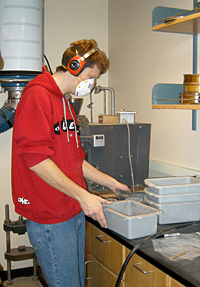
Exposure dating project pages
| ESS 461 home |
| Information |
| Lecture notes |
| Labs |
| Research project |
| Term papers |
| Reading |
| Web resources |
| Footnotes |
| FAQ |
Rock-crushing, Saturday 12 April, midday ...
Katherine, Dylan and Tomasz come in on the weekend to do the crushing.
Step 1: Sketch the samples, and measure thicknesses. Cosmic rays get stopped (attenuated) as they pass through rock, so production rates of cosmogenic isotopes decrease with depth. To calculate exposure ages we'll need to average the production rate of Be-10 over the thickness of each of the samples.
 |
Step 2: Grinding: Break the rock down to bite-size chunks. Feed these to the jaw crusher. Take the resulting grit and pass it through the disc mill, where it gets reduced to sand-sized grains.
Step 3: Sieve the crushed rock into size fractions: < 250 micrometers, 250-500 micrometers, 500-850 micrometers, and > 850 micrometers. We'll use about 150 grams of the 250-500 micrometer fraction for the quartz separation.